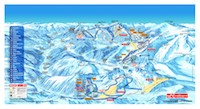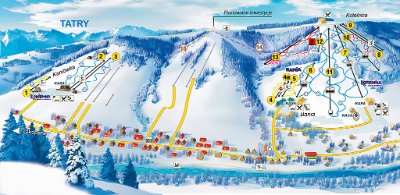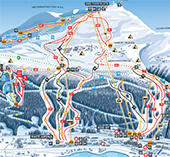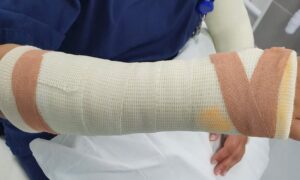It’s one of the BIG reasons expats look forward to living in Europe: Some of the best ski resorts in the world.
Gstaad. Chamonix. Sölden. Les Trois Vallée. St. Moritz. Klosters.
The names conjure visions of perfect off-piste slopes, parties, ski-in, ski-out chalets and, of course, après ski. Between them, Austria, France, Italy and Switzerland have eight of the 10 largest ski resorts in the world.
Except this time of year, actually getting to the Alps can be a test.
If you are an expat living in Munich, Zurich, Milan or Vienna, you’ve got it made. You can go directly to the slopes without much drama.
If you’re like the rest of us, driving or training from the United Kingdom, Netherlands, Belgium, Luxembourg or the flatlands of Germany and France, well, you should – as they say – plan for delays.
This year, the snow has returned after a disappointing 2017, but so have the traffic jams.
News sites are reporting that heavy snows in the Alps this year resulted in great skiing … along with nightmare traffic jams for people trying to return home from Christmas ski trips.
A few Christmases ago, our Germany-based friends got into what could have been a dangerous situation in the French Alps. Tim Bray had just picked up his wife, Rita Stephens, at the Geneva airport, and they and their son Stephen were headed down A41 to the slopes outside of Grenoble when they drove into a blizzard.
“We were stuck in traffic for 33 hours,” Rita told me. “There was no place where we could get off” the French auto route. “All the rest stops were parking lots, with cars parked everywhere; pointed in every direction. All the bathroom facilities were stopped up.”
There would be periods when they would creep forward at a few miles per hour for a few minutes, Rita said. “Then traffic would grind to a halt.”
So, savvy expat skiers and snowboarders, how do we avoid the Stau from Hell and the crazy airport check-ins?
What are our options?
Well, not as many as you’d think. Almost every autobahn in Germany is congested and under construction, and most expats live in areas where they simply must cross Germany in order to reach the ski areas.
The most notoriously slow routes are the A3 from Frankfurt toward Passau, and the A67 from Frankfurt toward Heidelberg. Oh, and the A5 from Darmstadt to Basel is also a lot of laughs. Though we took the A61 this year from our home in the Netherlands to Strasbourg and it was fairly clear and fast … in the middle of the summer.
For the winter, I would lower my expectations.
The question becomes, are there reasonably good ski areas close to populations centers?
The answer is, “Yes.” You can either try to stay closer to where you live, or you can fly to where people aren’t … at least not in droves. (Editor’s note: See “Dispatches’ 5 best small airports for your winter sun and snow escapes.”)
The easy-to-reach resorts are sometimes small and compared to the great Alpine resorts, pretty modest. Liam Gallahager won’t be there in concert. You won’t see movie stars or Formula One drivers. But they’re also far cheaper and stress-free if you just want a day out or a weekend of affordable outdoor fun. (In addition to skiing, some have dedicated slopes for sledding.)
There are a lot of small ski resorts in Germany outside the Alps for those of us living in the major expat cities of Amsterdam, London, Paris, Berlin, Brussels, Luxembourg City and the Dusseldorf/Cologne/Bonn megaplex.
If you have more than a weekend and are looking for an exotic destination easily reachable from most major European airport including Frankfurt and Manchester, let’s go to ….
• Georgia, the country
 The more we hear about Georgia, the more we want to go. And a ski trip would be a great intro to this country on the far eastern edge of Europe.
The more we hear about Georgia, the more we want to go. And a ski trip would be a great intro to this country on the far eastern edge of Europe.
Our fellow Eindhoven expat and Georgia native Tamara Pharadasvilli reminded us that Georgia has mountains, LOTS of snow and a growing ski scene.
The ski seasons runs from December through April, pretty much the same as France, Switzerland, Italy et al.
Now, here’s the best part:
You could go to Gstaad and spend 2,000 euros per day on hotels, food and lift tickets. OR, you could go to Georgia, where there are no crowds and prices start at about $15 per night (including meal) at a typical guest house. Fancy hotels run – are you ready for this? – $50 per night. Outrageous!
Day passes for the lifts start at about $8.
Here are some of Tamara’s suggestions:
• The SkiGeorgia website has a list of the best resorts including Bakuriani, a year-round resort. In the winter, it generally has at least 60 cm of snow and the most challenging ski runs in the country.
• Mestia is probably the best-developed resort area in Georgia, surrounded by mountains rising to 16,000 feet, almost as tall as Mt. Blanc. But it’s also pretty remote, a long drive from the capital Tblisi.
• Gudauri is also a well-developed complex high in the mountains, with skiing up to 4,200 meters (13,800 feet.) Gudauri offers four types of runs: slalom, giant slalom, super slalom and speed skiing.
• The newest resorts with the most up-to-date equipment are Goderdzi and Mitarbi.
Georgia is overlooked by most Europeans, but the good news is, you don’t need a visa to visit if you’re a citizen of a European Union country or American.
Also, everything we’ve read states that runs are well-groomed and resorts are equipped with modern Austrian and French lifts.
In most of the Alps, off-piste skiing is discouraged and/or controlled for many reasons including avalanche risks. In Georgia, go for it.
Finally, Georgia just added heli-skiing this winter, with Austrian and German firms providing the helicopters.
• Erbeskopf in the Hunsrück Mountains
 Erbeskopf Wintersportzplatz just north of the military communities around Kaiserslautern, Germany, which includes Ramstein Airbase and Landstuhl Hospital.
Erbeskopf Wintersportzplatz just north of the military communities around Kaiserslautern, Germany, which includes Ramstein Airbase and Landstuhl Hospital.
It’s close to about 40 percent of American military personnel based in Germany. High in the Hunsrück hills, the Erbeskopf winter sports center is an easy day trip from the Frankfurt/Wiesbaden area, a little farther from mega-expat centers in Düsseldorf, Brussels and Luxembourg City.
At 2,684 feet, Erbeskopf is the highest point in southwest Germany – though considerably lower than Alpine slopes down in Bavaria. Natural snowfall is a hit-or-miss proposition here.
And unlike Alpine runs, Erbeskopf is a bit length-challenged, with the longest of three runs only about 2,650 feet, with about a 500-foot drop in elevation. In addition to skiing, sledding is a thing here.
The one negative is, there’s no place to stay in area. The closest hotels are about 20 minutes away in Idar-Oberstein.
• The Black Forest
 There is also skiing in the Black Forest area south of Freiberg. Like Erbeskopf, the ski resorts of the Black Forest are modest, but longer, higher and more challenging. And like Erbeskopf, the Black Forest is a manageable drive from the Netherlands, Belgium and Luxembourg.
There is also skiing in the Black Forest area south of Freiberg. Like Erbeskopf, the ski resorts of the Black Forest are modest, but longer, higher and more challenging. And like Erbeskopf, the Black Forest is a manageable drive from the Netherlands, Belgium and Luxembourg.
The Feldberg – the highest mountain of the Black Forest – has an altitude of about 1,500 meters, or about 5,000 feet. There is natural or man-made snow most of the winter. At least according to the tourist bureau website.
From the Black Forest tourist bureau:
In the central ski area around the Feldberg, you will find: 4 chair lifts and 11 tow lifts servicing 16 downhill runs and 30 kilometres of pistes. There are also further lifts belonging to the Liftverbund Feldberg (Feldberg Ski Resort) in Altglashütten, Menzenschwand, Muggenbrunn and Todtnauberg. The complete ski region contains 31 lifts and 55 kilometres of ski pistes.
Along with skiing, the Black Forest area is chock-a-block with great lodges and hotels. Just remember to book ahead, because this is a popular tourist destination year-round.
• Barèges/La Mongie
 Anywhere in the Pyrenees Mountains on the border of France and Spain is going to be cheaper and easier to get to than the famous Alpine resorts. One of the largest is actually two resorts, referred to as Tourmalet Ski Area. The traditional village of Barèges is on one side of the Col du Tourmalet mountain pass, and La Mongie resort is on the other.
Anywhere in the Pyrenees Mountains on the border of France and Spain is going to be cheaper and easier to get to than the famous Alpine resorts. One of the largest is actually two resorts, referred to as Tourmalet Ski Area. The traditional village of Barèges is on one side of the Col du Tourmalet mountain pass, and La Mongie resort is on the other.
Together, Barèges and La Mongie have access to 240 kilometers of skiing with 138 individual pistes served by 43 ski lifts, according the J2SKI website.
Combined, the area offers challenging skiing. More challenging than Erbeskopf, that’s for sure. And there are plenty of places to stay.
The closest major airport is in Toulouse, about 70 miles away. But EasyJet flies there from Bristol and other discount airports, with prices starting about 25 pounds.
• Andorra
 For most long-term expats, Andorra is not exactly a secret. But this could be a fun change from the Alps.
For most long-term expats, Andorra is not exactly a secret. But this could be a fun change from the Alps.
And by the way, for those who’ve never heard of this small country, Andorra is right on the France/Spain border, 200 kilometers north of Barcelona, and about two hours by train from the Languedoc-Roussillon region in France which includes Montpellier.
It’s surrounded by the Pyrenees, so the whole country is pretty much a ski slope. There are two major snow ski areas: Grandvalira and Vallnord. Between them, they have – sit down for this – more than 300 kilometers of runs.
Grandvalira is the larger of the two with 210 kilometers of ski runs spread over 128 slopes. It includes Soldeu, Encamp, Canillo, El Tarter, Grau Roig and Pas de la Casa.
Andorra’s main claim to fame is affordability and remote skiing in this lightly populated country. Even the 5-star hotels are affordable compared to Switzerland … and lately, the culinary scene has begun to rival more expensive resorts, with 2-star Michelin restaurants arriving in the ski resorts.
We looked up flights, and it’s not that easy to get there, with the only direct flights from Toulouse (72 euros). One of the more direct ways to get to Andorra from Paris is via the TGV for about 172 euros one way.
• Almost anywhere in Bulgaria
 This is kind of funny. We’ve had several posts about Bulgaria lately, so I started looking into flights to Sofia and Varna. Much to my surprise, one of the best airports in Europe to fly from is Eindhoven, Netherlands, Dispatches’s global headquarters. Along with the Black Sea beach resorts, Bulgaria has some terrific skiing. The largest and most developed ski resorts in Bulgaria are Bansko, Borovets and Pamporovo.
This is kind of funny. We’ve had several posts about Bulgaria lately, so I started looking into flights to Sofia and Varna. Much to my surprise, one of the best airports in Europe to fly from is Eindhoven, Netherlands, Dispatches’s global headquarters. Along with the Black Sea beach resorts, Bulgaria has some terrific skiing. The largest and most developed ski resorts in Bulgaria are Bansko, Borovets and Pamporovo.
You can read our full post here about skiing in Bulgaria.
Borovets is the largest resort in Bulgaria, 1,350 meters above the sea level (with highest pistes at 2,600 meters), on the northern slopes of the Rila Mountains among pine woods, at the foot of Mousala peak (2,925 meters) the highest on the Balkan peninsula.
Borovets is easily accessible, only about 70 kilometers from Sofia’s airport.
The total length of the ski pistes is 58 km. The ski runs vary in difficulty. The pistes are grouped in 3 ski centres: pistes of Sitnyakovo – Martinovi Baraki region; 4 pistes of Markudjik region and 3 pistes of Yastrebets region. The best ski slopes are those of Yastrebets ski centre where all winter sports competitions take place.
The interesting thing about Bulgaria is, it’s far enough south that it doesn’t get very cold … just cold enough that it tends to get more – and more dependable – snowfalls than the Alps. Most of the ski centers also have multiple two-star, three-star and four-start lodgings for, oh, about a quarter of what you’d pay in the chi-chi resorts of Switzerland or France.
• The Tatras Mountains on the Poland/Slovakia border.
 We’ve had several people tell us lately this area can’t be beat for value or apres ski options.
We’ve had several people tell us lately this area can’t be beat for value or apres ski options.
Jasná is a Slovakian resort that’s getting a lot of pub from ski mags and bloggers, and Jasná Nízke Tatry is the largest ski area.
With the increasing popularity of Slovakia as a cool new travel destination, the investment here has been significant. Last year Jasná Nízke Tatry installed a new gondola with 15-seat cabins, completing the connection between the southern and northern parts of the ski area. This winter, snow cover on the Chopok peak will be improved by a new snow making system with 16 new snow guns, according to Inthesnow.com
There are also new and expanded runs.
Zakopane
The center for the skiing in Poland is Zakopane, which has an excellent website, breaking down the different slopes by difficulty.
Getting there … that’s another issue. The nearest airport to Jasná is Krakow, about a three-hour drive, according to Google. It looks like Bratislava or Budapest are your two other airport options.
•Åre, Sweden
 Okay, this is neither easy to reach (unless you live in Stockholm, which is 600 kilometers – 7 hours by car – to the south) nor inexpensive. But who knew they had Alpine skiing in Sweden? So it certainly qualifies as below-the-radar.
Okay, this is neither easy to reach (unless you live in Stockholm, which is 600 kilometers – 7 hours by car – to the south) nor inexpensive. But who knew they had Alpine skiing in Sweden? So it certainly qualifies as below-the-radar.
And if you’re looking for off-piste, watch the video. It’ll make you want to go like right now.
The SkiStart Åre complex claim’s northern Europe’s steepest vertical drop and 90 runs in the region, which includes Duved. There is also Åre Björnen bunny slopes for small kids and beginners.
The Åre website is super, with tons of data.
From Eindhoven, we can fly easily and inexpensively to Stockholm, so this is kind of tempting!
Here are the numbers:
41 lifts and 89 slopes
1 cable car
1 gondola
1 funicular
1 telemix (chair/gondola)78 chairlifts
11 button lifts
19 T-bar lifts
5 conveyor belts
18 green slopes
34 blue slopes
30 red slopes
4 black slopes
3 red/black slopes
Ski season: November – May
Vertical drop – 890 meters
Snow parks – Yes
Children-/beginners area -Yes
Co-CEO of Dispatches Europe. A former military reporter, I'm a serial expat who has lived in France, Turkey, Germany and the Netherlands.















